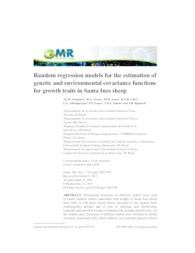Random regression models for the estimation of genetic and environmental covariance functions for growth traits in Santa Ines sheep.
Random regression models for the estimation of genetic and environmental covariance functions for growth traits in Santa Ines sheep.
Author(s): SARMENTO, J. L. R.; TORRES, R. A.; SOUSA, W. H.; LOBO, R. N. B.; ALBUQUERQUE, L. G.; LOPES, P. S.; SANTOS, N. P. S.; BIGNARD, A. B.
Summary: Abstract: Polynomial functions of different orders were used to model random effects associated with weight of Santa Ines sheep from birth to 196 days. Fixed effects included in the models were contemporary groups, age of ewe at lambing, and fourth-order Legendre polynomials for age to represent the average growth curve. In the random part, functions of different orders were included to model variances associated with direct additive and maternal genetic effects and with permanent environmental effects of the animal and mother. Residual variance was fitted by a sixth-order ordinary polynomial for age. The higher the order of the functions, the better the model fit the data. According to the Akaike information criterion and likelihood ratio test, a continuous function of order, five, five, seven, and three for direct additive genetic, maternal genetic, animal permanent environmental, and maternal permanent environmental effects (k = 5573), respectively, was sufficient to model changes in (co)variances with age. However, a more parsimonious model of order three, three, five, and three (k = 3353) was suggested based on Schwarz's Bayesian information criterion for the same effects. Since it was a more flexible model, model k = 5573 provided inconsistent genetic parameter estimates when compared to the biologically expected result. Predicted breeding values obtained with models k = 3353 and k = 5573 differed, especially at young ages. Model k = 3353 adequately fit changes in variances and covariances with time, and may be used to describe changes in variances with age in the Santa Ines sheep studied.
Publication year: 2016
Types of publication: Journal article
Unit: Embrapa Goats & Sheep
Observation
Some of Embrapa's publications are published as ePub files. To read them, use or download one of the following free software options to your computer or mobile device. Android: Google Play Books; IOS: iBooks; Windows and Linux: Calibre.
Access other publications
Access the Agricultural Research Database (BDPA) to consult Embrapa's full library collection and records.
Visit Embrapa Bookstore to purchase books and other publications sold by Embrapa.

